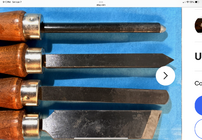-
It's time to cast your vote in the October 2025 Turning Challenge. (click here for details) -
Congratulations to Curt Fuller for "Bell Ornaments" being selected as Turning of the Week for October 27, 2025 (click here for details) -
Welcome new registering member. Your username must be your real First and Last name (for example: John Doe). "Screen names" and "handles" are not allowed and your registration will be deleted if you don't use your real name. Also, do not use all caps nor all lower case.
You are using an out of date browser. It may not display this or other websites correctly.
You should upgrade or use an alternative browser.
You should upgrade or use an alternative browser.
How many lathe tools are enough?
- Thread starter Webb Willmott
- Start date
I know that I have given away well over a hundred turning tools. I have sold probably 25 or so. If I were to count what are in all the drawers and cupboards I'm sure it would be north of 250, the majority of which are Hunter and Thompson. I had a box of Craftsman turning tools (I think there were 18) that were brand new. They were all black and smooth. I do not know if I still have them or if I gave them away. If I find them I'll post a picture.
Looked for them yesterday and I cannot find them so they were probably given away.
Looked for them yesterday and I cannot find them so they were probably given away.
Last edited:
In 1995, when I naively bought the POS Craftsman monotube bed lathe, I also bought their 4-piece tool set (small skew, diamond parting, small scraper, and something that one could mistake for a spindle-ish gouge sorta shape that in reality is just a tent stake).
I think the skew and scraper are still in a drawer. The gouge got thrown away when I bought a real spindle gouge a few months in. If I ever become king of the world, I'll outlaw all diamond profile parting tools, freeing turners everywhere from their miserable, misguided design and "benefits" of use (I'll stop at that), same with oval skews... what the "H" were they thinking? Anyway, What was I ranting about...? (You kids, get off my lawn!)
I think the skew and scraper are still in a drawer. The gouge got thrown away when I bought a real spindle gouge a few months in. If I ever become king of the world, I'll outlaw all diamond profile parting tools, freeing turners everywhere from their miserable, misguided design and "benefits" of use (I'll stop at that), same with oval skews... what the "H" were they thinking? Anyway, What was I ranting about...? (You kids, get off my lawn!)
If I ever become king of the world, I'll outlaw all diamond profile parting tools, freeing turners everywhere from their miserable, misguided design and "benefits" of use (I'll stop at that), same with oval skews... what the "H" were they thinking?
Interesting how our experiences differ. Parting tools: I use two fluted, one flat (Thompson) and four diamond cross-section (one large), and several micro parting tools. As I mentioned, the diamonds are my favorite for most things. But we each work differently.
I did have a student who had trouble with a diamond parting tool until I gently explained again and again how to use it. I do use a custom grind which makes the tool more useful than any of the stock grinds.
I will graciously accept donations of any “diamond” parting tools from unsatisfied owners. I could regrind them and the turning lives of several friends and students would be enriched.
And no attempt to be contrary: I keep and often use two oval skews, one I bought, the other I think given to me by someone who didn’t use a skew. They are more difficult to sharpen free-hand on a platform than flat-sided skews, but otherwise no different in use.
We can agree, however, on the monotube lathe! Mine was the Ridgid (copied or licensed) of the craftsman. It’s only redeeming feature was the excellent beginning turning course in the back of the lathe manual The Craftsnman 6-piece tool set was great and I still use it: wide skew, forged shallow spindle gouge, “continental” roughing gouge, round-nose scraper, parting tool, and can’t remember the other.
JKJ
There have been many valid reasons for having a large quantity of tools, particularly for those that are teaching.
While my own stash is in the 50-60 range, I don't do that much teaching these days. What I did observe was that scale and complexity of the various turning projects will dictate to some degree the special tool design to achieve the intended results. Examples below all required different tools, many being specifically ground.
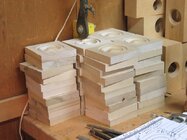
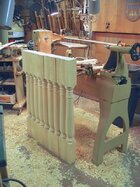
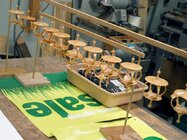
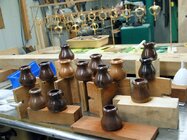
While my own stash is in the 50-60 range, I don't do that much teaching these days. What I did observe was that scale and complexity of the various turning projects will dictate to some degree the special tool design to achieve the intended results. Examples below all required different tools, many being specifically ground.




Hmm, which tools do I use most???? Well, as a bowl turner, once turned, I use scrapers for all of my heavy roughing, specifically the Big Ugly tool. I use a 40/40 grind for the outside of a bowl, and the 40/40 on the inside down to the transition, and then a BOB/bottom of bowl tool for the transition and across the bottom of the bowl. My favorite is a spindle detail gouge with a ) shape nose and a 70 degree bevel. I have a number of shear scrapers, a spear point for the outside and a couple of round nose or ) nose shape for the inside of the bowl. I have a number of NRSs/negative rake scrapers for the inside and outside of the bowls, but they work better on dry wood which I almost never turn. That covers my bowl tools, almost.....
robo hippy
robo hippy
Examples below all required different tools, many being specifically groundt
Ooo - it would be interesting to see the set of tools you use to make each one of those, especially the special grinds (unless they are carefully guarded secrets!) Might be an eye-opener for some and spur some new experimentation and interests!
I also grind some custom tools but only a few are unique to a particular project. I once hand to grind a tool to carefully cut the string drive grooves when making take-up spools on a friend's spinning wheel. Her spinning wheel came with just one spool.
For those who'd like to make a little money with turning, contact your local hand spinners guild. There are ALWAYS people to need wooden replacement parts for spinning wheels. Some want drop spindles for spinning by hand, easy to make. These allow making yarn from fibers anywhere. I even made a special "supported" spindle a friend wanted for spinning while riding on a bus.
Many drop spindles available cheaply and crudely made. We know someone who sold them from wooden wheels made for toys, fitted a dowel rod for the shaft, spray painted with colors. One made from good wood with some style is prized.
Bloodwood and maple.
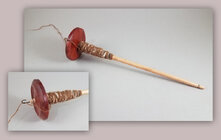
There is a world-wide community of fiber-arts enthusiasts - shearing, carding, spinning, felting, needle-felting, knitting, crocheting. When you have camelids, you meet many who want to buy fiber, especially alpaca. I could sell all the yarn bowls I could make. (but I don't sell)
JKJ
- Joined
- Jan 27, 2005
- Messages
- 13,169
- Likes
- 5,736
- Location
- Dalworthington Gardens, TX
- Website
- pbase.com
If I ever become king of the world, I'll outlaw all diamond profile parting tools, freeing turners everywhere from their miserable, misguided design and "benefits" of use (I'll stop at that), same with oval skews... what the "H" were they thinking? Anyway, What was I ranting about...? (You kids, get off my lawn!)
Strange as it may seem, I like my diamond parting tool and oval skews. I can understand why you don't like them if you don't have a Tormek. There was a special Tormek fixture for holding both of those tools. Unfortunately, Tormek revised the fixture so it no longer works as well with the diamond parting tool.
I like my ... oval skews. Tormek revised the fixture so it no longer works as well with the diamond parting tool.
I've sharpened the oval skews on the Tormek but never the diamond parting tools. For that I use the platform on the Wolverine. When I get a moment I plan to machine a jig to hold the tool perpendicular to the wheel. Sometimes I accidentally introduce a slight angle on the cutting edge and have to regrind.
But since I bought all the original jigs that Tormek had (back at the birth of Tormek, I think) and later bought a second (used) Tormek that came with more jigs, I looked through jig drawer and found the SVS-50 which looks like it could have been designed for the oval skew. Inside it has "V"s on either side to hold the edges and a lip that slides along the Tormek.
Long time ago I made an adapter to hold an extra Tormek tool guide bar so I could use it with a bench grinder AND not interfere with the Woverine/Varigrind use. I had to special order the bracket that holds the bar, made the mount of of white oak, cut away to clear the Wolverine handle.
I locked the oval skew into the Vs, set the angle to match what I'd ground by hand, set the bar distance for the bevel angle and with 30 seconds of sharpening on the 600 grit wheel plus a few seconds stropping had a perfect shaving-sharp edge. If not for your post I may have continued forever in my fumbling inefficient ways. Thanks!
I ALMOST remember using the jig for these skews a long time ago but forgot. (worthless memory...)
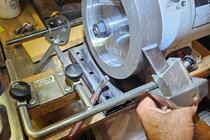
I do love the oval skews, find them easy to control, great for planing cuts.
Now, do you remember which jig will hold the parting tools?
I like my diamond parting tool ...
BTW, this is my gradual evolution towards the perfect diamond parting tool grind. It's getting closer but needs another go. By having the upper bevel curve to nearly horizontal as it meets the widest part of the tool it works more like a skew peeling cut. For me, this angle cuts quite well. The only thing I do with the bottom bevel is hone it lightly to resharpen a bit before going back to the grinder. I find the diamond cross-section shape perfect for clearance on the sides, especially if I very slightly twist the tool back and forth around the tool axis during the cutting, may just a couple of degrees in each direction.
Another reason I like this parting tool is the width of the cut is PERFECT for sizing with the kind of calipers I often use.
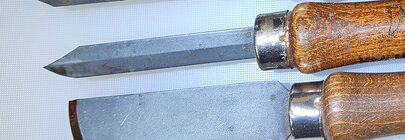
I was looking at some old Craftsman tools and the finish on the steel looked like orange peel paint or a rusted tool that was painted black. Then I looked at fleebay and all the sets looked that way. There must be a reason Craftsman lathe tools were finished that way. Why?
I pulled out all of my old HSS Craftsman tools. While the sides of the tools are not polished, they don't have the orange-peal surfaces you showed. I couldn't find the spindle roughing gouge, prob gave it away.
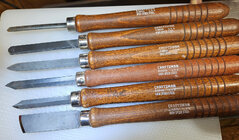
Could some over-zealous worker have had too much fun spraying? Is it a coating that will scrape off?
JKJ
The problem, by it's design, is that for a diamond parting tool to work properly by limiting tool contact within the kerf (its advertised benefit), the cutting edge has to be dead-on at the widest line of the cross section. If not, the wide section is not able to get into the relatively narrow kerf. In John's close-up image of the parting tool, the edge is below the widest point. Then, as John points out, you have to swing the handle left and right to widen the kerf to clear the widest cross section. But, with a normal, uniform width parting tool, one should swing the handle slightly left and right anyway (a fraction of a degree, hardly noticable in practice) to create clearance for the tool sides within the kerf. And placement of the edge on the height of the tool is not critical at all with a normal parting tool. So that begs the question, what is the point of the diamond parting tool if it takes more care and deliberate practice to keep it sharp?
Same for the oval skew, essentially the same shape as the diamond parting tool, but lacking the hard angles. Rounding the sharp corners of a rectangular section skew gets it to not beat up the tool rest, but with Sorby bringing the oval to market to solve the same issue, they went too far and removed a lot of steel from the tool. Completely unnecessary, and making it difficult to sharpen without complex jigs. 20+ years ago the discussion boards of the day were constantly criticizing oval skews.
Diamond parting tools and oval skew chisels, two tools trying to offer solutions to problems that never existed.
Same for the oval skew, essentially the same shape as the diamond parting tool, but lacking the hard angles. Rounding the sharp corners of a rectangular section skew gets it to not beat up the tool rest, but with Sorby bringing the oval to market to solve the same issue, they went too far and removed a lot of steel from the tool. Completely unnecessary, and making it difficult to sharpen without complex jigs. 20+ years ago the discussion boards of the day were constantly criticizing oval skews.
Diamond parting tools and oval skew chisels, two tools trying to offer solutions to problems that never existed.
Officially the correct number is n+1, d-1
Where n is the number presently owned, and d is the number that results in a trip to the courthouse...
Where n is the number presently owned, and d is the number that results in a trip to the courthouse...
- Joined
- Feb 6, 2010
- Messages
- 3,420
- Likes
- 2,503
- Location
- Brandon, MS
- Website
- threeringswoodshop.square.site
@John K Jordan You probably didn't know that @Webb Willmott also builds airplanes so may be overloaded with aeronautical tools but still working on turning tools.
I know I have 28 wood planes but no idea how many turning tools. Most definitely more than the number of planes.
I know I have 28 wood planes but no idea how many turning tools. Most definitely more than the number of planes.
I know I have 28 wood planes but no idea how many turning tools. Most definitely more than the number of planes.
I have more than a dozen each of drawknifes and spokeshaves for Windsor chair making. Far fewer than the number of turning tools.
Strength in numbers!
Remember what happened to that guy who said “One tool to rule them all!”

Remember what happened to that guy who said “One tool to rule them all!”
You might ask this question at the symposium trade show of the guy with 5 bags, one of which is the last tool he'll need....
I use four. 1/2" bowl gouge, skew, parting tool and interior bowl scraper.
One tool away from greatness. When I get that tool I will have enough.
One tool away from greatness. When I get that tool I will have enough.
I'll send you that tool. I obviously haven't used it.
The problem, by it's design, is that for a diamond parting tool to work properly...Then, as John points out, you have to swing the handle left and right to widen the kerf to clear the widest cross section.
I just saw this. I usually don't swing the tool handle from side to side. That would be a problem for a deep parting/sizing cut. I find it better to gently twist the tool handle, left and right (counterclockwise then clockwise), an entirely different motion:
"I find the diamond cross-section shape perfect for clearance on the sides, especially if I very slightly twist the tool back and forth around the tool axis during the cutting, may just a couple of degrees in each direction."
I reiterate: I love the diamond parting tool. I like the tapered fluted ones too, use two different sizes, but the diamond gives a nice flat bottom for perfect sizes where that's critical.
JKJ
Last edited:
You are correct, good sir, you did not say "swing". Sorry about that.I just saw this. I usually don't swing the tool handle from side to side. That would be a problem for a deep parting/sizing cut. I find it better to gently twist the tool handle, left and right (counterclockwise then clockwise), an entirely different motion:
"I find the diamond cross-section shape perfect for clearance on the sides, especially if I very slightly twist the tool back and forth around the tool axis during the cutting, may just a couple of degrees in each direction."
I reiterate: I love the diamond parting tool. I like the tapered fluted ones too, use two different sizes, but the diamond gives a nice flat bottom for perfect sizes where that's critical.
JKJ
I still think diamond parting tools and oval skews should be dumped into the middle of the ocean! Okay, a bit harsh. Take them to the scrap yard. Or, use them to pop weeds out of the lawn, there we go!
I still think diamond parting tools and oval skews should be dumped into the middle of the ocean! Okay, a bit harsh. Take them to the scrap yard
If HSS, you can always grind them into some custom tool. I do that.
Better yet, send them all to me. I and other turners I know will use them.
JKJ
Thanks for the offer, John, but I already re-ground the diamond parting tool many years ago, and I own no oval skews.If HSS, you can always grind them into some custom tool. I do that.
Better yet, send them all to me. I and other turners I know will use them.
JKJ
I didn't grind the diamond profile completely flat to make a rectangular tool, but I flattened it a good 1/4" or more on each side, and now the cutting edge does not need to land critically on the widest part of the diamond rib dimension. Including the top and bottom flats, the cross section is now a rectangular-shaped octogon (i.e. does not have 8 equal sides) rather than a hexagon. If this would have been the original intent of Sorby et al, the tool would have always worked just fine. But as a diamond profile, one needs to have critical placement of the cutting edge right on the very widest line of the diamond shape for the tool to work. If not, the tool will not enter the kerf; it will not cut at all.
But as a diamond profile, one needs to have critical placement of the cutting edge right on the very widest line of the diamond shape for the tool to work. If not, the tool will not enter the kerf; it will not cut at all.
Yes, of course, shouldn't need to be said to keep the cutting edge at the max width. I've started grinding my diamond parting tools this way, they cut well (and also never bind if used properly):
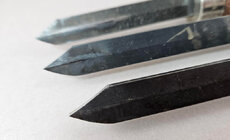
I've experimented with different grind profiles. The one at the bottom is my favorite so far.
It does make them "one side always up" tools. I had to put a red "X" and a blue dot on the bottom and top of the handle of one to remind a student!
Note that the parting tool that Doug Thompson makes is entirely rectangular in shape, machined from 1/2" round bar stock. It also works well.
Don't have to worry about having to understand the evil width of the diamond parting tool.
Note that for decades people have ground thin parting tools from kitchen butter and other knives. John Lucas made one from a drywall saw blade. He also made one for his miniatures from a kitchen paring knife with a tapered blade. A google search will show lots of options.
One thing to remember about parting tools in general - if making a very deep cut with any parting tool, say deep sizing or even parting off a box or bowl, it's helpful to make clearance cuts on one side of the groove. A clearance cut doesn't have to take off much, just a "whisper" is enough.
Another thing I always do when using one to part off the work is never cut all the way to the middle. This will avoid breaking the last little bit and the risk of pulling fibers from wood, likely making holes difficult to repair. Instead, I part until the piece is held by just a very thin cylinder, then stop the lathe and use a thin saw to cut the last little bit. I clean up the nub by hand with a sharp skew.
This video might be helpful. Dick Sing mentions right off the bat that parting tools are often misunderstood. He shows a variety, with his favorites made from flat bar stock 1/8" and 1/16" thick. He also mentions the importance of a sharp parting tool! Duh. (They are cutting tools, not scraping tools.) Some of his grinds are interesting. He illustrates the movements needed for a deep cut, the same curve you would use when making deep peeling cuts with a skew. He points out the importance of grinding a diamond parting tool so the cutting edge is at the widest point.
JKJ
My favorite it a standard rectangular, 1/8" wide, about 3/4" tall, that I bought from Packard a bunch of years ago. I think it is a Crown, maybe a Taylor, regular ol' M2 HSS.
The concave/slightly convex in John's photo, a pro that demo'ed here in MN 20-some years ago showed that profile, and I went right home and did that to my diamond tool, right after I flattened the diamond profile. Works well as a result of the more acute bevel angle at the edge.
The concave/slightly convex in John's photo, a pro that demo'ed here in MN 20-some years ago showed that profile, and I went right home and did that to my diamond tool, right after I flattened the diamond profile. Works well as a result of the more acute bevel angle at the edge.
Last edited:
- Joined
- Jan 27, 2005
- Messages
- 13,169
- Likes
- 5,736
- Location
- Dalworthington Gardens, TX
- Website
- pbase.com
I've sharpened the oval skews on the Tormek but never the diamond parting tools. For that I use the platform on the Wolverine.
I was confused about the diamond parting tool. Actually, the Tormek jig has not changed. The Sorby sizing tool is the thing that has changed. It no longer has a notch for holding the diamond parting tool.
Question along the same line.... Does anyone still find at yard sales, Estate sales, ect? . I head guy saying in older You tube videos. I never found any in all yard sales type things. Gotta watch ads for estate sales more
Question along the same line.... Does anyone still find at yard sales, Estate sales, ect? . I head guy saying in older You tube videos. I never found any in all yard sales type things. Gotta watch ads for estate sales more
I usually get old turning tools from other woodturners I know. Sometimes they get new tools and have more sense then me and give away or sell the old tools. At one demo I mentioned how much I liked a particular parting too - the next meeting someone gave me his!
Our club has a Silent Auction every Dec at the Christmas party that benefits the club - lots of times people bring and donate tools, maybe some they don't use anymore, sometimes they don't understand what they have, and others don't see the value. I got an brand new Grex random orbital sander this way a few years back for $30 - it normally sells for over $125. I take tools there too - last one was a massive scraper I hadn't used in forever. Sometimes people donate tools to our annual wood auction.
Sometimes people give me tools they don't use much since they know I sometimes teach and send some students home with tools.
I haven't been to a yard sale since can't remember when.
On that note, may I introduce you all to the work of Golding Fiber Tools. Golding’s RingSpindles are likely the most immediately relevant to this audience. But you’re really, really missing out if you skip their Spinning Wheels. Was turning involved? Almost certainly… but. The spindles are stunning, but the wheels are the true passion projects.There is a world-wide community of fiber-arts enthusiasts
I usually get old turning tools from other woodturners I know. Sometimes they get new tools and have more sense then me and give away or sell the old tools. At one demo I mentioned how much I liked a particular parting too - the next meeting someone gave me his!
Man I wish I could get that lucky! Where I live way out so far I dont thing any other Ol timers around here... I will start keeping my eyes looking for some. Im retired and returning after several years.. onward and upward!
On that note, may I introduce you all to the work of Golding Fiber Tools. Golding’s RingSpindles are likely the most immediately relevant to this audience. But you’re really, really missing out if you skip their Spinning Wheels. Was turning involved? Almost certainly… but. The spindles are stunning, but the wheels are the true passion projects.
Incredible! I've never seen any that fancy!
I've turned replacement parts to fix my own spinning wheels and those of friends.
The hardest was making some extra bobbins for a girl with an old spinning wheel and just one bobbin. I had to grind a point tool with a special tip to change the taper at the tip. A straight v-groove wasn't ideal since the string might bind in the pulley. Fortunately I had the original bobbin to copy!
JKJ
Last edited:
I have a few dozen tools, some of them rarely used, but I do use just about all of them. I use a Thompson 5/8" V bowl gouge the most. That plus a shaped scraper for jaw shoulders, a Thompson 1/2" spindle gouge, a pair of 1/2" thick negative rake scrapers and my Jamieson hollowing bar are in regular use, probably 90% of the time. If I were only turning bowls I could get by just fine with the gouges and scrapers mentioned.
Last edited:
Kevin the first tool I got from Doug Thompson was a 5/8 V and that has been my go to tool ever since. I probably have 8 backups in the drawer. For years early on Thompsons were the only tools I used but when I discovered Hunter carbide I found tools that sometimes replaced a Thompson in use and they also allowed me to get rid of more than a few of my hollowing tools. I met Randy Privett early on so I have both (captured and articulated) Monster hollowing systems of which I use the articulated almost a 100% of the time anymore. I have a drawer full of Kelton Hollowers that I should think about getting rid of as they get very little use anymore.
You can never have too many tools. NEVER! Remember…. When you die…. The one with the most tools wins! Would any of you like my address? If you have Thompson, Hunter, Drodza or Simple tools that are in your way, you can always mail them to me. Thank You!!Like this. Many sets of the HSS look this way.
Thom Schuck
Portland, Oregon
only the current one.
My Craftsman monotube lathe is still out in my shed… untouched for the last 25 years since I upgraded to a Jet. I think I bought every accessory Sears sold for it. I do occasionally use some of my original Craftsman HSS turning tools, though I now have multiple far superior choices.In 1995, when I naively bought the POS Craftsman monotube bed lathe, I also bought their 4-piece tool set (small skew, diamond parting, small scraper, and something that one could mistake for a spindle-ish gouge sorta shape that in reality is just a tent stake).
My experience is similar.For years early on Thompsons were the only tools I used but when I discovered Hunter carbide I found tools that sometimes replaced a Thompson in use
I still think diamond parting tools and oval skews should be dumped into the middle of the ocean! Okay, a bit harsh. Take them to the scrap yard. Or, use them to pop weeds out of the lawn, there we go!
I remembered this when I noticed the comment Brian Haven's made with his video on skew types, referring to rectangular vs oval:
"Each type of skew has its proponents, sometimes even to the point of disparaging the other, while other turners find little difference between the two."
All opinions are valid and provide interesting perspectives! Imagine how boring life would be if we all used only the same tools, did the same type of turning, made the same forms from the same type of wood... Creativity, RIP.
But the scrap yard or garden use might be better than dumping them all in the ocean, especially all at once - what if the descending cloud of oval skews stabbed some innocent shark, baby whale, or freediver? And what a waste of good handles.
Speaking of scrap/recycling yards - we have a wonderful local one. Not only do they buy scrap but they sort out potentially useful things and sell them to anyone at near scrap prices. I've come home with big blocks of aluminum for milling, brass, bronze, titanium, magnesium, huge sheets of HDPE, nylon, teflon, a pressure vessel, fastener hardware, and even a box full of surgical tools (that had some amazing tools, some of which an accordion repair guy I know was thrilled to get because of their unique reach!) Spread the joy. Could anyone use a 10' length of new 1/2" thin wall titanium tubing, bought for less than 1% of of the original cost? I have plenty.
JKJ
I've seen the on Craigslist in recent times for a couple hundred bucks, almost new prices from 30 years ago.My Craftsman monotube lathe is still out in my shed… untouched for the last 25 years since I upgraded to a Jet. I think I bought every accessory Sears sold for it. I do occasionally use some of my original Craftsman HSS turning tools, though I now have multiple far superior choices.
A few weeks in with my then-new monotube bed lathe, turning some modest spindle shape, I had a tool catch, whose force went back down the banjo and was stopped by the riveted key bar on the bottom of the bed tube. Several rivets were stressed loose, and probably the key bar bent, too. Called the Sears 800 phone number and they sent out a new bed tube for free.
I naively struggled through with that lathe for almost 2 years, then replaced it with a 6-speed Jet 1014 mini lathe, in the new and exciting white color (!). My God, what a step up that was!!
Anyone remember that after Sears went bust, HD had that lathe mfr build it for them under the Rigid brand. Same junk, different paint job. I don't think that lasted too long. I think the Jet mini, with its eventual bed extension, then variable speed motor, (and turners talking to each other on usenet discussion boards, and then website boards) did in that monotube lathe and other truly bottom quality lathes, like the Harbor Freight stuff of the times. The Jet mini was in the +/- $350 range back then, only about $50 more than Sears/HD.
The problem... my problem with oval skews and diamond parting tools is that they were solutions to problems that did not exist, and we've been buying them up because we fall for the marketing. Rather than put a simple radius on the bottom edge of the rectangular skew to keep the hard corners from chewing up our cast iron toolrests (which would have been innovative, because we didn't have hardened drill rod tool rests yet), Sorby removes about 40% of the steel from the tool with that oval shape, and makes it darn difficult to sharpen without a dedicated jig system. And I've already beaten the diamond parting tool issue to death above, so...I remembered this when I noticed the comment Brian Haven's made with his video on skew types, referring to rectangular vs oval:
"Each type of skew has its proponents, sometimes even to the point of disparaging the other, while other turners find little difference between the two."
All opinions are valid and provide interesting perspectives! Imagine how boring life would be if we all used only the same tools, did the same type of turning, made the same forms from the same type of wood... Creativity, RIP.
JKJ
So, yep, in my ever-so-humble opinion, those two tool profiles can be retired by their manufacturers, and then use the same amount of effort to make the proper, time-tested profiles. Or even better, design new, innovative tools that actually are designed to do something better. Those two tools are not better mousetraps. They're snake oil.
The extinct monotube bed, oval skews, diamond parting tools. Other than those three items, the woodturning tool and equipment realm has served their customers pretty well over the past 30 years or so. Thompson, Carter, Robust, Oneway... Hunter. I was in the MN Woodturners Association 20-some years ago when local hobby woodturner and specialty industrial tooling-guy Mike Hunter was first designing his new woodturning tools, derived from the industrial metal turning. I have one of his first experimental round carbide disc scrapers in a tool drawer, he gave a few to some club members to test out for feedback. And look where he is today. Now there's a whole new world of mousetraps!
Last edited:
john lucas
AAW Forum Expert
I love my oval skew. I can't tell any difference in use. It does not seem to flex any more than my Thompson skew. Early on it was harder to sharpen. Now I simply find the bevel and free hand grind. It's no more difficult than my Thompson or the 6 other skews I still have after my skew grinds testing.

